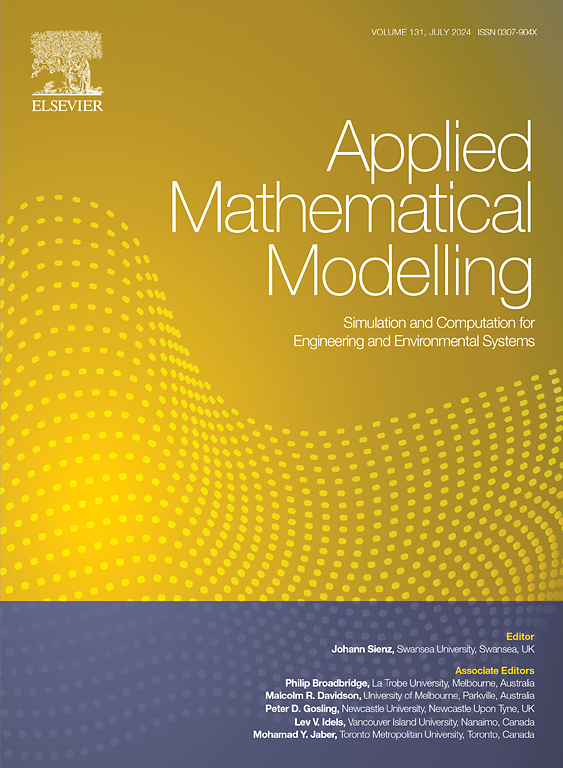Asymmetric nonlinear instability of thermally induced microsize arches having dissimilar boundary conditions incorporating strain gradient tensors
IF 4.4
2区 工程技术
Q1 ENGINEERING, MULTIDISCIPLINARY
引用次数: 0
Abstract
In the featured research investigation, the roles of different microstructural-dependent strain gradient tensors in the asymmetric nonlinear instability characteristics attributed to microsize arches having dissimilar boundary conditions subjected to thermal ambience amalgamated with a mechanical concentrated load applied in various positions. It is supposed that the microsize arches are constructed by functionally graded porous material reinforced by graphene platelets at nanoscale. The individual nonlinear dominate equations are extracted based upon the exponential shear deformation formulations of curved beam comprising modified strain gradient theory (MSGT) of continuum mechanics. Thereupon, the isogeometric analysis (IGA) employing non-uniform rational B-Splines is carried out to discretize and interpret the nonlinear problem on the basis of the displacement conformation in terms of the nodal values. Knot insertion along with the multiplication are considered to describe the discontinuities of internal forces caused by the applied mechanical concentrated load. It is demonstrated that by moving the locus of the applied concentrated load nearer to the simply supported end in comparison with the clamped one, the detected limit points reduce from four number to two number. In other words, the multitude of limit points allocated to the MSGT-based nonlinear asymmetric instability of FGP microsize arches relies upon the position of the imposed concentrated load. Moreover, it is discovered that by shifting the imposed concentrated load to a locus more neighboring to the clamped end, the prominence associated with the effect of microscale gradient tensors on the limit values increases, while by shifting it to a locus more neighboring to the simply supported end, this prominence tends to be reduced.
含应变梯度张量的不同边界条件下热致微尺寸拱的非对称非线性不稳定性
在有特色的研究中,研究了不同微观结构相关的应变梯度张量在不同边界条件的微尺寸拱在热环境和不同位置的机械集中载荷混合作用下的不对称非线性失稳特性中的作用。假设微尺度的拱形结构是由石墨烯片在纳米尺度上增强功能梯度多孔材料构成的。基于连续介质力学中修正应变梯度理论的曲线梁指数剪切变形公式,提取了曲线梁的非线性控制方程。在此基础上,采用非均匀有理b样条等几何分析(IGA),以节点值为基础对位移构象进行离散化和解释。考虑了由机械集中荷载引起的内力不连续性的插入结和乘法。结果表明,通过将集中荷载的位置移动到离简支端较近的位置,检测到的极限点由4个减少到2个。换句话说,分配给基于msgt的FGP微尺寸拱非线性不对称失稳的极限点数量取决于施加集中荷载的位置。此外,研究发现,通过将施加的集中载荷移到更靠近夹紧端的位置,与微尺度梯度张量对极限值的影响相关的突出值增加,而将其移到更靠近简支端的位置,这种突出值趋于减少。
本文章由计算机程序翻译,如有差异,请以英文原文为准。
求助全文
约1分钟内获得全文
求助全文
来源期刊

Applied Mathematical Modelling
数学-工程:综合
CiteScore
9.80
自引率
8.00%
发文量
508
审稿时长
43 days
期刊介绍:
Applied Mathematical Modelling focuses on research related to the mathematical modelling of engineering and environmental processes, manufacturing, and industrial systems. A significant emerging area of research activity involves multiphysics processes, and contributions in this area are particularly encouraged.
This influential publication covers a wide spectrum of subjects including heat transfer, fluid mechanics, CFD, and transport phenomena; solid mechanics and mechanics of metals; electromagnets and MHD; reliability modelling and system optimization; finite volume, finite element, and boundary element procedures; modelling of inventory, industrial, manufacturing and logistics systems for viable decision making; civil engineering systems and structures; mineral and energy resources; relevant software engineering issues associated with CAD and CAE; and materials and metallurgical engineering.
Applied Mathematical Modelling is primarily interested in papers developing increased insights into real-world problems through novel mathematical modelling, novel applications or a combination of these. Papers employing existing numerical techniques must demonstrate sufficient novelty in the solution of practical problems. Papers on fuzzy logic in decision-making or purely financial mathematics are normally not considered. Research on fractional differential equations, bifurcation, and numerical methods needs to include practical examples. Population dynamics must solve realistic scenarios. Papers in the area of logistics and business modelling should demonstrate meaningful managerial insight. Submissions with no real-world application will not be considered.
 求助内容:
求助内容: 应助结果提醒方式:
应助结果提醒方式:


